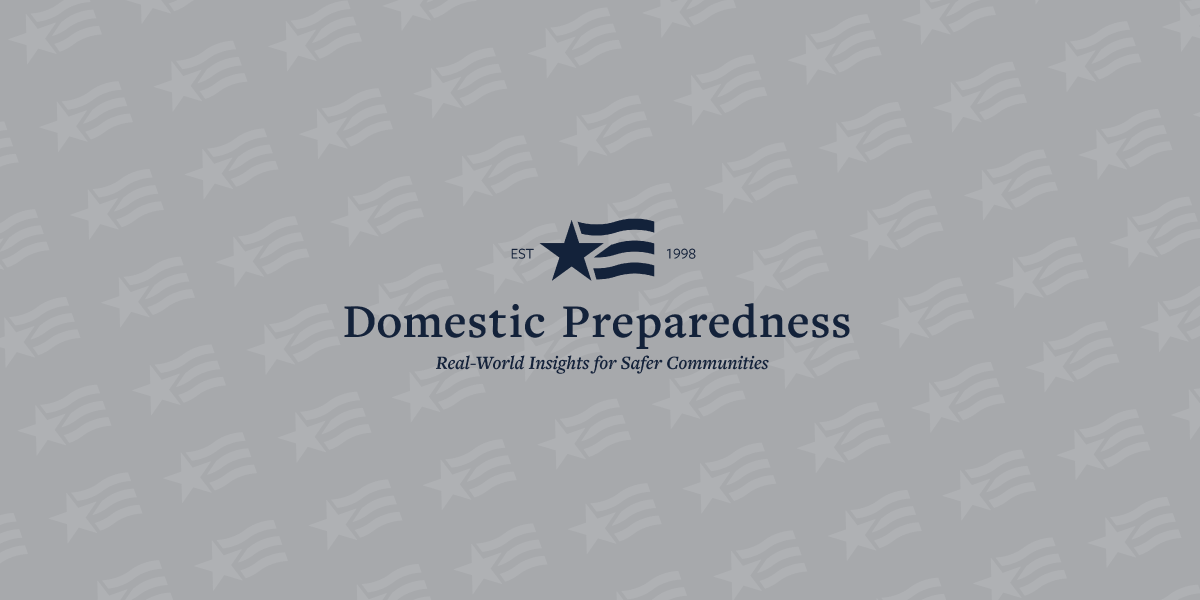Most recently published

Asymmetric Warfare: Redefining Standard Terms
Ashley Moore
June 14, 2005
Chaos and confusion reign not just on the battlefield but also, particularly in recent times, in policy pronouncements, position papers, and the public consciousness. Principal problem is a proliferation of acronyms meaning almost the same thing – but not

CERFPs: A New Resource for Emergency Response
Christopher M. Schnaubelt
June 14, 2005
The National Guard creates new units to deal with mass disasters. After the first responders come the WMD-CST teams, and behind them, providing a second protective shield for the American people, come the twelve CEFRP units, stationed in FEMA regions thro

John Thomasian, Director, National Governors Association Center For Best Practices
John F. Morton
June 14, 2005
Director of the National Governors Association Center for Best Practices reports on the proceedings of last week’s National Executive Forum for State Homeland Security Directors. Also included is a discussion of the so-called intelligence fusion centers.

Michigan, New York, Washington, and Florida
Anthony Lanzillotti
June 1, 2005
Michigan plays a perfect game before defending the Great Lakes; New York considers the purchase of an advanced helicopter for firefighting, rescue operations; the state of Washington conducts its first bioterrorism exercise; and Florida sets aside a speci

Workloads and Respiratory Rates: The Key Factors in Respiratory Protection
Rob Schnepp
June 1, 2005
Breathing is not easy for anyone involved in the responses to and cleanup of hazardous materials. The task is much more difficult, though, when the equipment provided to first responders is less than adequate, and deficient in many other ways.

Coming Soon: A National EMS Administration?
Joseph Cahill
June 1, 2005
Today’s EMS community is a full partner on the nation’s homeland-security first-responder team, but gets short shrift in funding, in representation at the White House and on Capitol Hill, and in media attention. One way to even out the playing field might be to establish a national office representing city,

Guest Commentary: Resolving
Buck Somes
June 1, 2005
GenPrime V.P. suggests a new paradigm for the handling of emergency calls – many of them hoaxes – reporting the presence of anthrax-like substances that might be cornstarch, baby powder, or coffee creamer. Or anthrax. The use of on-site broad-spectrum screen can be used to determine a “threat/no threat” result

Oklahoma, Texas, Indiana, and Kansas
Anthony Lanzillotti
May 18, 2005
Oklahoma continues to provide more resources for first responders and counterterrorism personnel; new partnerships in homeland security and emergency preparedness formed in Texas; Indiana agencies address suspicious activity and fraud; Kansas responders.

ALPR Systems and How They Grew
Jay Kehoe
May 18, 2005
Crime-fighting goes high-tech with the introduction and increasing use of affordable, relatively compact, and user-friendly OCR and ALPR technology. Today, speeders are the most likely target. Tomorrow and the day after it will be known criminals and/or s

A Long Tradition of Voluntary National Service
Brent Bankus
May 18, 2005
The recent spate of articles and commentaries about the “Minuteman” group that, without invitation, helped the U.S. Border Patrol apprehend over 300 illegal migrants is a timely reminder that other citizen groups have provided significant homeland-defense

“The Week That Was” in Washington, D.C.
James D. Hessman
May 18, 2005
Orders to “Run for your life!” were followed in short order by the announcement of new port-security grants and the Pentagon’s latest list of base closings, consolidations, and realignments. All three became major national stories, and all are related – i

SNL and Merlin: A New Way to Look at Decontamination
Rob Schnepp
May 4, 2005
The war against bioterrorism moves forward – at less than flank speed – from the water-based decon agents of the 1990s to faster and much more effective peroxide-based solutions that can be used to deactivate biological pathogens and TICs as well as the CW agents.

Virginia, North Carolina, and Wisconsin
Anthony Lanzillotti
June 15, 2005
Virginia Develops free emergency resources for businesses, but imposes security fees on incoming oceanborne cargoA new online resource – the Virginia Business Emergency Survival Toolkit (available at www.vaemergency.com/business) – has been developed by a group of emergency organizations in Virginia that includes information and other resources that the state’s businesses can use

Asymmetric Warfare: Redefining Standard Terms
Ashley Moore
June 14, 2005
Chaos and confusion reign not just on the battlefield but also, particularly in recent times, in policy pronouncements, position papers, and the public consciousness. Principal problem is a proliferation of acronyms meaning almost the same thing – but not

CERFPs: A New Resource for Emergency Response
Christopher M. Schnaubelt
June 14, 2005
The National Guard creates new units to deal with mass disasters. After the first responders come the WMD-CST teams, and behind them, providing a second protective shield for the American people, come the twelve CEFRP units, stationed in FEMA regions thro

John Thomasian, Director, National Governors Association Center For Best Practices
John F. Morton
June 14, 2005
Director of the National Governors Association Center for Best Practices reports on the proceedings of last week’s National Executive Forum for State Homeland Security Directors. Also included is a discussion of the so-called intelligence fusion centers.

Michigan, New York, Washington, and Florida
Anthony Lanzillotti
June 1, 2005
Michigan plays a perfect game before defending the Great Lakes; New York considers the purchase of an advanced helicopter for firefighting, rescue operations; the state of Washington conducts its first bioterrorism exercise; and Florida sets aside a speci

Workloads and Respiratory Rates: The Key Factors in Respiratory Protection
Rob Schnepp
June 1, 2005
Breathing is not easy for anyone involved in the responses to and cleanup of hazardous materials. The task is much more difficult, though, when the equipment provided to first responders is less than adequate, and deficient in many other ways.

Coming Soon: A National EMS Administration?
Joseph Cahill
June 1, 2005
Today’s EMS community is a full partner on the nation’s homeland-security first-responder team, but gets short shrift in funding, in representation at the White House and on Capitol Hill, and in media attention. One way to even out the playing field might be to establish a national office representing city,

Guest Commentary: Resolving
Buck Somes
June 1, 2005
GenPrime V.P. suggests a new paradigm for the handling of emergency calls – many of them hoaxes – reporting the presence of anthrax-like substances that might be cornstarch, baby powder, or coffee creamer. Or anthrax. The use of on-site broad-spectrum screen can be used to determine a “threat/no threat” result

Oklahoma, Texas, Indiana, and Kansas
Anthony Lanzillotti
May 18, 2005
Oklahoma continues to provide more resources for first responders and counterterrorism personnel; new partnerships in homeland security and emergency preparedness formed in Texas; Indiana agencies address suspicious activity and fraud; Kansas responders.

ALPR Systems and How They Grew
Jay Kehoe
May 18, 2005
Crime-fighting goes high-tech with the introduction and increasing use of affordable, relatively compact, and user-friendly OCR and ALPR technology. Today, speeders are the most likely target. Tomorrow and the day after it will be known criminals and/or s

A Long Tradition of Voluntary National Service
Brent Bankus
May 18, 2005
The recent spate of articles and commentaries about the “Minuteman” group that, without invitation, helped the U.S. Border Patrol apprehend over 300 illegal migrants is a timely reminder that other citizen groups have provided significant homeland-defense

“The Week That Was” in Washington, D.C.
James D. Hessman
May 18, 2005
Orders to “Run for your life!” were followed in short order by the announcement of new port-security grants and the Pentagon’s latest list of base closings, consolidations, and realignments. All three became major national stories, and all are related – i
Dirty Bombs: The Impossible Becomes Probable
Neil C. Livingstone
May 4, 2005
Surplus uranium, inadequate controls, and undetected smuggling are the key ingredients of a future nuclear disaster on U.S. soil. Today, almost any nation in the world is capable of building Hiroshima-sized nuclear devices, RDDs, and/or dirty bombs.
Missouri, Rhode Island, and Nevada
Anthony Lanzillotti
May 3, 2005
Missouri, Rhode Island, and Nevada By Anthony Lanzillotti Missouri Funeral Directors seek help with PPE funding Funeral home directors in Missouri have asked the state to help them obtain federal funding for the purchase of personal protective equipment (PPE). The request came after a recent meeting of the directors to discuss
Ohio, California and Minnesota
Anthony Lanzillotti
April 20, 2005
A dirty bomb is hidden inside a vessel at a port facility somewhere on Lake Erie. SWAT teams, more than 180 first responders, and a large number of EMS student victims are among the many-splendored participants in an extended counter-terrorism exercise at Ohio Tests Lake Erie Dirty-Bomb Scenario Just two weeks
Virtual Exercises: They’re the Real Thing!
Joseph Cahill
April 20, 2005
Frequent and effective training is one of the keys to carrying out an adequate domestic-preparedness plan of any type. Such training costs money, though, and funds are scarce.
Ohio, Hawaii, California, and Minnesota
Domestic Preparedness
April 20, 2005
Ohio Just two weeks before the large “TOPOFF3” exercise tapped major resources in New York, New Jersey and Connecticut, the state of Ohio held a small tabletop exercise focusing on the threat of a sea borne radiological dispersal device. The scenario included a “dirty bomb” hidden within a vessel
Risks and Realities, Grants and Vulnerabilities
James D. Hessman
April 20, 2005
The mostly successful launch of the Department of Homeland Security has been followed, not surprisingly, by allegations of wasteful spending and a failure to establish priorities. The new team at DHS meets the challenge head-on, and is already working wit
Pennsylvania, Massachusetts, Illinois, and Wyoming
Anthony Lanzillotti
April 6, 2005
In this issue: Pennsylvania seeks funds for rural areas. Massachusetts updates biological-warfare defense plans. Illinois awards grants to TechAlt, Midco. Wyoming upgrades its inland-waterways capabilities.
Needed: Revisions to Maritime Response Standard
Ashley Moore
April 6, 2005
NFPA 1405 tells land-based firefighters how to respond to fires aboard ships in port. But some essential details are missing, and should be included in future (revised) editions.
Upgrading an Armory: The 1033 Solution
Jay Kehoe
April 6, 2005
The handgun, the shotgun, and the rifle – each has its advantages and disadvantages. But today’s law-enforcement officer needs at least one effective weapon not only to carry out his duties but also to protect himself and the thousands of innocent people
Larry Roth, Assistant Executive Director, American Society of Civil Engineers
John F. Morton and Martin D. Masiuk
April 6, 2005
The assistant executive director and COO of the American Society of Civil Engineers shares his views on, among other topics, the ASCE’s latest “Report Card” on America’s Infrastructure, and EPA grants and funding for vulnerability assessments.
Increases, Shortfalls, and Nightmare Scenarios
James D. Hessman
April 6, 2005
President Bush’s fiscal year 2006 budget plan calls for increased funding for port and maritime security. Some members of Congress say that that is only a start, and significant additional funds are needed – ASAP.
Maryland, Georgia, Arizona, & Mississippi
Anthony Lanzillotti
March 23, 2005
This issue: Maryland focuses on assistance grants; Georgia assigns responsibilities to Homeland Security Task Force; Arizona continues TOPOFF4 planning; and Mississippi provides a full calendar of training options.
Follow Us
Get Instant Access
Subscribe today to Domestic Preparedness and get real-world insights for safer communities.


